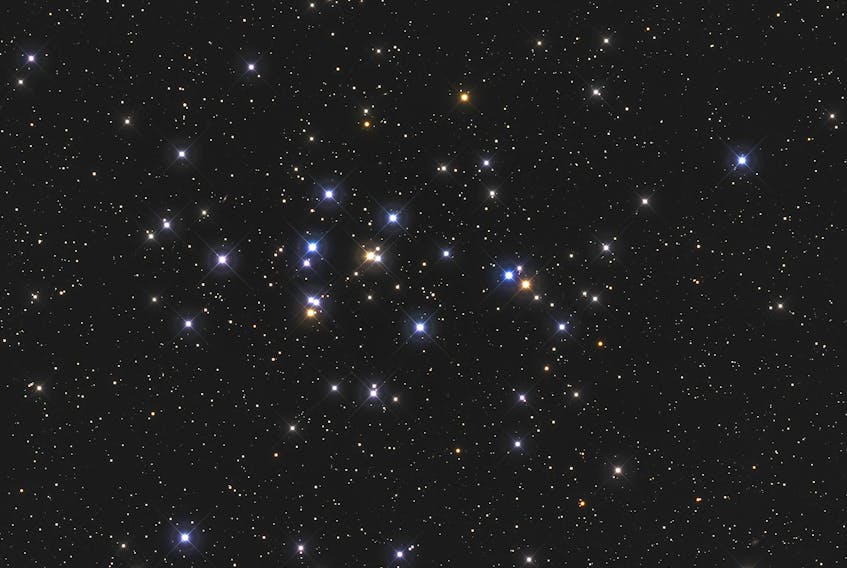Did you know there's a swarm of celestial bees in the night sky?
When you look up at the springtime night sky, there are two prominent constellations you may be able to spot. Leo - the Lion, and Gemini - the Twins can be found in the south-southwest sky between 9 p.m. and 10 p.m. on spring evenings.
You'll find Leo about halfway up the southern sky, with the distinctive reversed "?" shape of the lion's head facing towards the southwest (right).
Halfway between Leo and Gemini (to the right of Leo) is Cancer - the Crab. It is here, in this not-so-prominent constellation of faint stars, that we find one of the most beautiful open star clusters in the night sky: Praesepe, the "Beehive Cluster" (or M44 in the Messier Catalogue listing).
Visible to the naked eye (on a clear night and away from city lights) as a faint, nebulous patch of light, Praesepe (magnitude +3.7) is a beautiful sight in binoculars. It is composed of 1,000 or more blue-white stars with a sprinkling of reddish-orange stars among them. It is located approximately 577 light-years from Earth and is estimated to be about 600 million years old (our sun is approximately 4.5 billion years old).
Exactly how Praesepe came to be associated with bees is unclear. The ancient Greeks referred to it as "Phatne" (from pateomai, meaning "to eat"). The Greek poet Aratus (c. 315 - 240 BC) wrote of it as "Achlus" (meaning "little mist"), while the Greek astronomer Hipparchus (c. 190-120 BC) referred to it as "Nephelion" ("little cloud").
The ancient Romans called it "Praesepe," which is Latin for "crib" or "manger" (as in a stable). The great Roman astronomer and mathematician Ptolemy (c. 100 - 170 AD), referred to it as "the nebulous mass in the breast of Cancer."
Both the Greeks and Romans associated the cluster's two most prominent stars - Gamma and Delta Cancri - with two donkeys said to have carried two of the Olympian gods, Dionysus and Silenius, into battle against the Titans. It seems that the braying of the donkeys so frightened the Titans that they fled the battlefield, giving victory to the Olympians. The gods rewarded the two donkeys by placing them in the night sky in Praesepe, where they could eat hay eternally from the manger.
Some scholars assert that the Latin "praesepe," in addition to meaning "crib" or "manger," can also mean "hive," thus providing a possible link between the star cluster and bees. Others point to "Samson's riddle" found in the Old Testament Book of Judges. Samson, an ancient Israeli judge and renowned strongman, made a wager with several Philistines guests at his wedding feast, wherein they had to answer the following riddle: "Out of the eater came something to eat, and out of the strong came something sweet." (Judges 14:14).
The answer to the riddle was based - unbeknownst to the Philistines - on a personal experience that Samson had. It seems that one day, while out walking, Samson killed a lion, and upon returning a day or so later to the scene of the battle, found that bees had constructed a hive inside the lion's carcass, from which he extracted some honey. Thus, the answer to Samson's riddle was - "What is sweeter than honey? What is stronger than a lion?" (Judges 14:18).
Over time, it's possible Samson's lion came to be associated with the constellation of Leo - the Lion, which represented the Nemean lion killed by the great Greek hero Hercules as part of his Twelve Labours, and that, perhaps, this association led to the "Beehive Cluster" being placed close by the constellation of Leo. There doesn't appear to be any association of Praesepe with Cancer - the Crab.
Grab your binoculars and head outdoors some clear night between 9-10 p.m. in the coming weeks, and look for the Beehive Cluster; you won't be disappointed, it really does look like "a swarm of celestial bees."
This week's sky
Mercury is not visible this coming week, as, being very close to the sun right now, it won't clear the southeast horizon until shortly before sunrise and is lost in the dawn's glow.
Venus is likewise unobservable, as it is heading towards superior solar conjunction (it will pass behind the sun as seen from Earth) on March 26, whereupon it will transition from the morning sky to the evening sky, becoming visible again in April.
Mars (magnitude +1.2, in Taurus - the Bull) continues as an early evening object this week. It becomes visible 52 degrees above the southwest horizon by about 8:10 p.m., before dropping towards the horizon and setting around 1:35 a.m.
Saturn (magnitude +0.7, in Capricornus - the Sea-Goat) and Jupiter (magnitude -2.0, in Capricornus) are both briefly visible low above the southeast horizon in the pre-dawn sky, before being washed out by the brightening dawn.
The full moon on March 28 is often referred to as the "Worm Moon" as March is often when earthworms can be seen crawling on the ground's surface in most areas throughout North America.
Until next week, clear skies.
Events
- March 26 - Venus at superior solar conjunction
- March 28 - Full "Worm" Moon
Glenn K. Roberts lives in Stratford, P.E.I., and has been an avid amateur astronomer since he was a small child. He welcomes comments from readers at [email protected].









